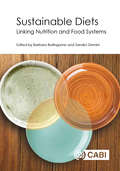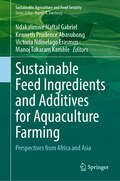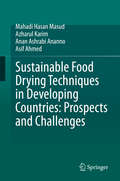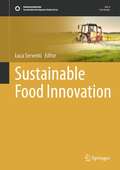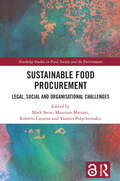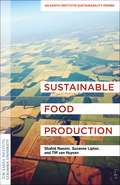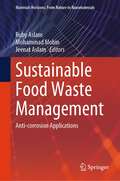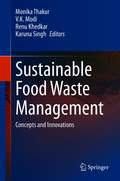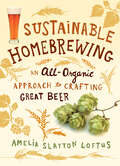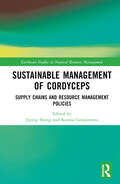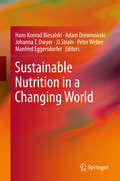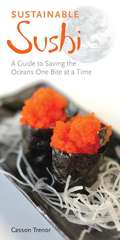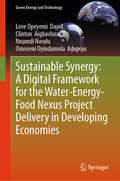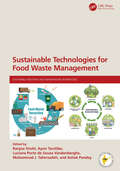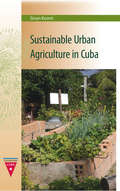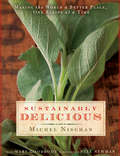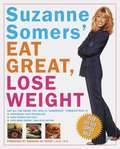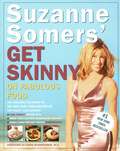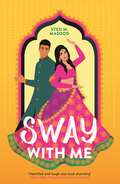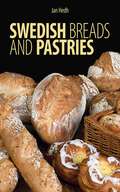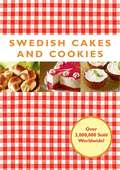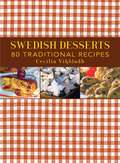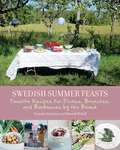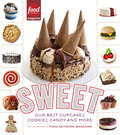- Table View
- List View
Sustainable Diets: Linking Nutrition and Food Systems
by Barbara Burlingame Sandro DerniniThis book takes a transdisciplinary approach and considers multisectoral actions, integrating health, agriculture and environmental sector issues to comprehensively explore the topic of sustainable diets. The team of international authors informs readers with arguments, challenges, perspectives, policies, actions and solutions on global topics that must be properly understood in order to be effectively addressed. They position issues of sustainable diets as central to the Earth's future. Presenting the latest findings, they: - Explore the transition to sustainable diets within the context of sustainable food systems, addressing the right to food, and linking food security and nutrition to sustainability. - Convey the urgency of coordinated action, and consider how to engage multiple sectors in dialogue and joint research to tackle the pressing problems that have taken us to the edge, and beyond, of the planet's limits to growth. - Review tools, methods and indicators for assessing sustainable diets. - Describe lessons learned from case studies on both traditional food systems and current dietary challenges. As an affiliated project of the One Planet Sustainable Food Systems Programme, this book provides a way forward for achieving global and local targets, including the Sustainable Development Goals and the United Nations Decade of Action on Nutrition commitments. This resource is essential reading for scientists, practitioners, and students in the fields of nutrition science, food science, environmental sciences, agricultural sciences, development studies, food studies, public health and food policy.
Sustainable Feed Ingredients and Additives for Aquaculture Farming: Perspectives from Africa and Asia (Sustainability Sciences in Asia and Africa)
by Ndakalimwe Naftal Gabriel Kenneth Prudence Abasubong Victoria Ndinelago Erasmus Manoj Tukaram KambleThis book describes sustainable aquaculture ingredients and additives uncovered in Africa and Asia. It also discusses current aquaculture research practices on alternative protein, carbohydrate, lipid, mineral, vitamin, and feed additives. It further demonstrates how aquaculture practices could be a feasible and cost-effective venture, capable of producing products in an environmentally sustainable manner. The aquaculture industry is suffering from scarcity of sustainable feedstuffs, particularly protein and oil components, which play an important role in the nutritional requirements of many aquaculture species. The availability of components such as fish meal, fish oil, and other synthetic feed additives has rendered aquaculture operations unsustainable, particularly in terms of cost. Therefore, the quest to replace such unsustainable components is developing in Africa and Asia. This book helps aquaculture farmers, researchers, the aquafeed industry, investors, students, lawmakers, and other stakeholders in the aquaculture field to comprehend scientific-based sustainable feed ingredients and additives in aquaculture from an African and Asian viewpoint.
Sustainable Food Drying Techniques in Developing Countries: Prospects and Challenges
by Azharul Karim Mahadi Hasan Masud Anan Ashrabi Ananno Asif AhmedThis book presents a comprehensive review of renewable energy-based sustainable drying techniques for developing countries. Aspiring towards a world with zero food waste, the book has provided discussion on sustainable drying techniques in terms of energy efficiency. The socio-economic condition of each developing country is unique; therefore, has specific technological requirements. As such, the book presents discussions on food waste scenario around the world, the socio-economic status of developing countries and their correlation with food. The book gives an overview of the quality aspects of drying, along with the required energy and time to retain these features. Additionally, a method of selecting drying techniques for developing countries, taking the cost and safety factor into consideration, has been discussed extensively Also, the renewable and non-renewable energy resources of low income, lower-middle income, middle income, and high-income developing countries have been analyzed and presented. The book also highlights the available drying techniques that are currently being practiced by the consumers and industries of developing countries. The book recommends ten sustainable drying technologies for the developing countries and describes their working principle. Discussion on potential challenges for sustainable drying technology adoption is also presented. The book presents up-to-date research on sustainable drying techniques and their impact on developing countries to reduce food waste.Food waste is not only a humanitarian concern but also a threat to environmental sustainability. Currently, one-third of all produced food is being wasted, when nearly 805 million people - including children remain undernourished on a daily basis. In an effort to solve this crisis, a number of food preservations techniques are being practiced in food supply chain. Drying is one such preservation technique that prevents microbial proliferation, slows enzymatic reaction and preserves the physio-chemical properties of food. Albeit, drying is an effective means of food preservation; it is also highly energy-intensive. Developing countries do not have sufficient energy and financial resources to adopt conventional (expensive and high energy) drying techniques. As such, this is the first reference work dedicated to discussing the prospects and challenges of sustainable (renewable energy based and inexpensive) drying techniques for developing countries in order to reduce food waste. Sustainable food drying techniques in developing countries: Prospects and Challenges is a singular work in the field of food preservation and affordable drying technology.
Sustainable Food Innovation (Sustainable Development Goals Series)
by Luca ServentiThis text offers a holistic approach to the two topics of the highest interest in the current and future food industry: sustainability and nutrition. The current knowledge is narrow and specific to individual topics focusing on either one nutrient or one discipline. Food is part of a wide circle of disciplines: nutrition, technology, sensory, environmental aspects, psychology, economy, culture and society. In the recent years, the sales of innovative foods such as meatless burgers, allergen-free products and personalized nutrition have skyrocketed. Sustainable Food Innovation presents the big picture on each nutrient: industrial and natural sources (ingredients, food products), consumer acceptability (price, sensory quality) and nutritional properties (quantity and quality) with each chapter focusing on a specific essential nutrient. Further chapters illustrate the role of other elements of interest such as bioactive. In addition, experimental data is added to enrich the book. Online discussions on current food trends are analyzed and presented to the reader in the effort to understand consumers’ psychology. This will be the first publication to combine literature review and research data and the first to offer a comprehensive discussion on sustainable food innovation. The ultimate goal is to educate consumers and experts, providing technical and socioeconomic knowledge in a multidisciplinary context. Ultimately, informed technologists will develop healthier, sustainable food products and informed consumers will make informed decisions on nutrition and food choices.
Sustainable Food Procurement: Legal, Social and Organisational Challenges (Routledge Studies in Food, Society and the Environment)
by Mark Stein Roberto Caranta Maurizio Mariani Yiannis PolychronakisThe book examines sustainable food procurement policy and practice in the European Union and beyond, exploring the extent to which sustainability objectives have been achieved and evaluating the new developments taking place at both EU and national levels.While there is a growing recognition that public authorities can use public procurement as a policy tool to pursue multiple environmental, health and socio-economic objectives, contracting authorities still face many challenges. This volume investigates the scope for pursuing sustainable objectives in public procurement of food and catering services, examining different regulatory contexts and organisational models to answer the overall question of how to integrate sustainability concerns into the various phases of public food procurement processes. Contributions in the book examine the policy and legal procurement framework and practices for sustainable public catering in three EU Member States: Italy, France and Spain. There is a comparative survey of the Baltic Region, including Denmark, Estonia, Finland, Poland and Russia, and moving beyond the EU, there is examination of the UK and Brazil, as well as a cross country comparison of the UK with Denmark and Sweden. Drawing on the expertise of an interdisciplinary and intersectoral team of contributors allows the book to benefit from the insights of different disciplines, including business sciences, anthropology and law. Tapping into the global discussion on public food procurement as a means to achieve multiple social and environmental goals, this work will stimulate readers looking for new creative ways to create value through public food purchasing.This book will be of great interest to students, researchers, policymakers and public- and private-sector representatives interested in public procurement, food policy and law, sustainable food sourcing and supply chain management.
Sustainable Food Production: An Earth Institute Sustainability Primer (Columbia University Earth Institute Sustainability Primers)
by Dr. Shahid Naeem Suzanne Lipton Tiff van HuysenIndustrial agriculture is responsible for widespread environmental degradation and undermines the pursuit of human well-being. With a projected global population of 10 billion by 2050, it is urgent for humanity to achieve a more sustainable approach to farming and food systems.This concise text offers an overview of the key issues in sustainable food production for all readers interested in the ecology and environmental impacts of agriculture. It details the ecological foundations of farming and food systems, showing how knowledge from the natural and social sciences can be used to create sustainable alternatives to the industrial production methods used today. Beginning with a discussion of the role of agriculture in human development, the primer examines how twentieth-century farming methods are environmentally and socially unsustainable, contributing to global change and perpetuating inequalities. The authors explain the principles of environmental sustainability and explore how these principles can be put into practice in agrifood systems. They emphasize the importance of human well-being and insist on the centrality of social and environmental equity and justice.Sustainable Food Production is a compelling guide to how we can improve our ability to feed each other today and preserve the ability of our planet to do so tomorrow. Appropriate for a range of courses in the natural and social sciences, it provides a comprehensive yet accessible framework for achieving agricultural sustainability in the Anthropocene.
Sustainable Food Waste Management: Anti-corrosion Applications (Materials Horizons: From Nature to Nanomaterials)
by Mohammad Mobin Jeenat Aslam Ruby AslamThis book highlights established research and technology on corrosion inhibitors and bio-waste management. It further discusses emerging aspects of utilizing food waste in the field of corrosion inhibition. The topics covered include overview on bio-waste and their management, different types of food waste (i.e., agricultural, vegetable and fruit/fruit juice, plant waste, slaughterhouse trash), and their application as corrosion inhibitors and mitigation of corrosion. It also discusses economic aspects and commercialization of food waste as corrosion inhibitors. The book is a valuable reference for beginners, researchers, and professionals working in the areas of sustainability, food waste management, and material science.
Sustainable Food Waste Management: Concepts and Innovations
by Karuna Singh Monika Thakur V. K. Modi Renu KhedkarThis book discusses one of the biggest challenges of the food industry, which is waste management. Food industries generate high amounts of waste, both solid and liquid, resulting from the production, processing and consumption of food. Stringent environmental legislators have made the task of waste management more challenging. Through the three sections of this book, the readers are introduced to the different types of wastes generated, utilization of waste through food processing industry and sustainable waste management technologies. The different chapters describe how the biomass and the valuable nutrients from food industry wastes could be used to develop value-added products. The book reiterates that food wastes and their by-products are an excellent source of sugars, minerals, dietary fiber, organic acids, bio active compounds such as polyphenols, carotenoids and phytochemicals etc.This book is an excellent resource for industry experts, researchers and students in the field of food science, food processing and food waste management.
Sustainable Homebrewing: An All-Organic Approach to Crafting Great Beer
by Amelia Slayton LoftusBrew delicious organic beer at home. In this comprehensive guide, Amelia Slayton Loftus covers everything you need to know to brew at home with organic ingredients, stressing practices that minimize waste and use sustainable resources. Along with 30 irresistible recipes, Loftus provides expert tips on buying equipment, harnessing solar energy, recycling water, using spent grain, and growing your own organic barley, hops, and herbs. You’ll enjoy brewing homemade beer that not only tastes great, but is good for the environment.
Sustainable Management of Cordyceps: Supply Chains and Resource Management Policies (Earthscan Studies in Natural Resource Management)
by Ksenia Gerasimova Jiping ShengThis book examines the challenges of sustainably managing and conserving Cordyceps sinensis, a rare species of fungus largely grown in Tibet, currently on the brink of extinction.As one of the most expensive commodities in the world, particularly valued for its medicinal properties in China, the price of Cordyceps has risen by over 900% since the 1970s. This has made it a very lucrative resource for farmers, many of whom are struggling to produce sufficient food to sustain themselves. Naturally, this has led to overharvesting and, coupled with the impacts of climate change, the crop itself is now at risk. Rarely discussed in Western literature, this book provides a novel examination of Cordyceps, looking into the necessary changes needed to sustainably manage and conserve this important crop. Drawing on extensive field work conducted in Qinghai-Tibet, the book analyzes the supply chain, identifying key issues around production and considering the role and impact of relevant stakeholders. It discusses the necessary changes needed for a sustainable supply change, particularly to stop long-term overharvesting. The book then discusses the role of policy and the institutional management of this resource in China, as one of the main producers and consumers. It analyzes current policy instruments and argues for a more coherent policy which is better orientated towards conservation and sustainable management, rather than solely market regulation.This book will be of great interest to students and scholars of natural resource management, environmental conservation, environmental policy, and sustainable supply chain management.
Sustainable Nutrition in a Changing World
by Hans Konrad Biesalski Adam Drewnowski Johanna T. Dwyer Jj Strain Peter Weber Manfred EggersdorferThis book is the first of its kind to tackle in detail the nutritional requirements of the industrialized, so-called developed world. It discusses the link between socio-economic status and food security, focusing especially on the relationship between income and food security in different age groups. The authors calculate the actual levels of essential micronutrients delivered by current dietary patterns, identifying important shortfalls in the provision of key micronutrients, and elucidate the public health consequences of nutrition insecurity. Finally, the authors discuss future approaches for ensuring nutrition security on the basis of three pillars: access, availability and nutritional value. The approaches advocated in this ground-breaking publication will allow all people, irrespective of age and social status, to have access to a safe and nutritious diet. Key stakeholders such as legislators, government, academia and industry, as well as consumers themselves, all have important roles to play in making this a reality.
Sustainable Sushi
by Casson TrenorSustainable Sushi answers the question on the minds of millions who enjoy eating fish: how can we indulge the desire to dine well while keeping our health and the health of the oceans in mind? With painstaking research found in no other book on the market to date, this pocket-size guide profiles dozens of the most common fish and shellfish one might encounter at a sushi bar, details where and how they are caught, whether or not they are safe, and how they figure in the current fishery crisis. Written by a fishery and sustainability expert who was himself netted long ago by the allure of Japanese cuisine, Sustainable Sushi offers simple, clear explanations of such topics as mercury and PCB levels, overfishing, and species extinction. Attractively designed and featuring quick facts, the book was written for both the novice and the seasoned sushi fan. In a storm of seafood shortages and frightening statistics,Sustainable Sushi shows readers how to enjoy the sushi bar without guilt.
Sustainable Synergy: A Digital Framework for the Water-Energy-Food Nexus Project Delivery in Developing Economies (Green Energy and Technology)
by Clinton Aigbavboa Nnamdi Nwulu Omoseni Oyindamola Adepoju Love Opeyemi DavidThis book introduces a comprehensive and sustainable project delivery framework tailored for managing the Water, Energy and Food (WEF) nexus in developing economies. Its primary objectives include establishing the determinants of the nexus, exploring the sustainability dynamics of the resources, delineating the role of digital technologies in WEF nexus projects, evaluating the interoperation of the three resources with sustainable development goals (SDGs) and subsequently formulating a sustainable project delivery framework. Timely in its release, the book provides essential policy directions and technological perspectives within the realms of sustainability. Water, energy, and food (WEF) resources constitute vital components pivotal for a nation's socio-economic development and fundamental for human survival due to their intricate interdependencies. Recognizing their paramount importance, the World Economic Forum underscores their role in a country's growth trajectory. However, the sustainable management of WEF resources in the era of the Fourth Industrial Revolution necessitates an integrative framework for project delivery. Unfortunately, a significant gap exists in understanding the determinants of the nexus between water, energy, and food resources, resulting in insecurity in their management. Compounding this challenge, the emergence of new technologies in the fourth industrial revolution has not received adequate consideration for ensuring resource security. The book adopts a meticulous approach, conducting an in-depth review of existing models, frameworks, and theories. Furthermore, it supplements this analysis with an insightful interview case study. Notably, this pioneering work distinguishes itself as the first to view WEF resources as interconnected nexus projects, with a keen acknowledgment of the indispensable role played by digital technology. Moreover, its targeted focus on addressing the unique challenges prevalent in developing economies adds a layer of specificity often absent in existing literature on the WEF nexus. Researchers seeking a deeper understanding of the integration between the WEF nexus and digital technologies will find substantial value in the contents of this book. The book is divided into five sections, providing a systematic exploration of the subject. The sections cover background information on WEF resources and its nexus, underpinning theories of resource interaction, theoretical frameworks relevant to the nexus, the role of digital technologies in managing the WEF nexus, interoperation of sustainability and SDG with the nexus, presentation of an in-depth case study and conclude with valuable insights and recommendations.
Sustainable Technologies for Food Waste Management (Sustainable Industrial and Environmental Bioprocesses)
by Ranjna Sirohi, Ayon Tarafdar, Luciana Porto de Souza Vandenberghe, Mohammad J. Taherzadeh, and Ashok PandeyThis book comprehensively explores various aspects of food waste management, ranging from understanding the issue to innovative solutions that convert waste into valuable resources. The initial chapters provide an in-depth analysis of advanced methods for characterizing food waste. The book examines cutting-edge methodologies, including physico-chemical, thermal, and biological approaches, for converting food waste into valuable resources such as biohydrogen, biopolymers, biogas, organic acids, bioactive compounds, biochar, compost, and vermicompost. Additionally, it delves into the utilization of advanced technologies like machine learning, the Internet of Things (IoT), sensors, and robotics for food waste treatment and management, thus contributing to a sustainable future. It underscores the conversion of food waste into renewable energy sources, sustainable materials, and valuable compounds. This book will be useful for researchers, practitioners, and policymakers seeking sustainable approaches to tackle the global challenge of food waste. Offers in-depth insights into advanced methods for characterizing food waste, enabling precise and targeted waste reduction strategies Examines physico-chemical, thermal, and biological approaches for converting food waste into valuable resources Presents machine learning, IoT, sensors, and robotics for sustainable food waste management and treatment Highlights the conversion of food waste into valuable resources, including biohydrogen, biopolymers, bioactive compounds, compost, and vermicompost Provides specific details about the food waste supply chain and associated policies
Sustainable Urban Agriculture in Cuba: Sustainable Urban Agriculture In Cuba (Contemporary Cuba)
by Sinan Koont"Pushed by necessity but enabled by its existing social and educational policies, Cuba in the 1990s launched the most extensive program of urban sustainable agriculture in the world. This study is to date the only book-length investigation in either English or Spanish of this important national experiment in transforming the environmental, economic, and social nature of today's dominant system of producing food."--Al Campbell, University of Utah As large-scale industrial agriculture comes under increasing scrutiny because of its petroleum- and petrochemical-based input costs and environmentally objectionable consequences, increasing attention has been focused on sustainable, local, and agro-ecological techniques in food production. Cuba was forced by historical circumstances to be one of the pioneers in the massive application of these techniques. After the demise of the Soviet Union in the early 1990s, Cuba was left without access to external support needed to carry on with industrial agriculture. The economic crisis led the country to reconsider their former models of resource management. Cuba retooled its agricultural programs to focus on urban agriculture--sustainable, ecologically sound farming close to densely populated areas. Food now takes far less time to get to the people, who are now better nourished because they have easier access to whole foods. Moreover, urban farming has become a source of national pride--Cuba has one of the best urban agriculture programs in the world, with a thousand-fold increase in urban agricultural output since 1994. Sinan Koont has spent the last several years researching urban agriculture in Cuba, including field work at many sustainable farms on the island. He tells the story of why and how Cuba was able to turn to urban food production on a large scale with minimal use of chemicals, petroleum, and machinery, and of the successes it achieved--along with the continuing difficulties it still faces in reducing its need for food imports.
Sustainably Delicious: Making the World a Better Place, One Recipe at a Time
by Mary Goodbody Michel NischanMore than any other chef at work today, Michel Nischan creates sophisticated, modern food by embracing the food tenets of the past: Use what's readily available, celebrate variety, respect the land, and eschew waste. Whether it's explaining the virtues of secondary meat cuts, which fish are in least danger of overfishing, or how heritage bean and grain varieties help to support biodiversity as well as healthy diets, Sustainably Delicious proves that the most satisfying food comes from a passionate respect for America's culinary and environmental legacy. Many of the recipes reflect Nischan's Midwestern roots and the innate frugality that dictated his family's meals be made with humble, seasonal ingredients. In Nischan's confident hands, simple foods such as barley, celery root, and eggs shine. With recipes such as Heirloom Beet Salad with Savory Marshmallows, Tomato Rice Soup with Braised Beef Shanks, and Leg of Pasture-Raised Lamb Stuffed with Chestnuts and Dried Cranberries, Nischan's approach to farm table cuisine is anything but precious.
Suzanne Somers' Eat Great, Lose Weight: Eat All the Foods You Love in "Somersize" Combinations to Reprogram Your Metabolism, Shed Pounds for Good, and Have More Energy Than Ever Before
by Suzanne Somers Barbara M. DixonNo one knows the self-denial--and the failure rate--of dieting better than Suzanne Somers. The Three's Company and Step-by-Step star struggled with her weight for twenty years. But now, after years of experimentation and consultation with more than one hundred nutritionists and dietitians, Suzanne has developed a weight-loss plan that truly succeeds. With over a hundred recipes for great-tasting creative and traditional dishes, Eat Great, Lose Weight will help you free yourself from food cravings, get off the diet roller coaster, and learn to love food again. You won't believe how easy it is to look and feel your best!
Suzanne Somers' Get Skinny on Fabulous Food
by Suzanne Somers Diana SchwarzbeinAfter the phenomenal success of Eat Great, Lose Weight, Suzanne Somers was flooded with letters and phone calls from people who had lost weight the "Somersize" way. They had followed Suzanne's satisfying and effective program and for the first time had gained control over their weight and their health. There was no more dieting, no more deprivation, and the pounds just seemed to melt away.Now, Suzanne takes readers to the next step toward greater health and fitness in Suzanne Somers' Get Skinny on Fabulous Food. With breakthrough research on food and our bodies, an easy-to-follow weight-loss plan, and more than 130 amazing new Somersized recipes, this book is a must-read for anyone looking to shed pounds or maintain their weight--even while eating meat, cheese, butter, dressings, desserts, and other delicious foods not found on most eating plans. Backed up by renowned endocrinologist Dr. Diana Schwarzbein, Suzanne tells how sugar, not fat, is responsible for weight gain, and how combining food properly and eating a diet that is low in carbohydrates and that includes plenty of natural fats and proteins will not only help you lose weight but also can reprogram your metabolism, lower your cholesterol and blood pressure, and give you more energy.Somersizing is not a diet, but a way of life. In Get Skinny on Fabulous Food you will find inspiring testimonials from some of Suzanne's greatest success stories, people who have lost weight, lowered blood pressure, and eliminated digestive problems by Somersizing. And you can join Suzanne and her family as they celebrate good food and good times throughout the year with dinners, brunches, and other special-occasion meals that are perfectly Somersized yet perfectly delicious. It is almost impossible to believe you can lose weight and still feel so indulged! Best of all, Suzanne shares more than 130 new mouthwatering Somersized recipes, including Milanese Beef with Sautéed Onions and Mushrooms in a Port Wine Sauce, Spicy Rock Shrimp Salad, Fried Rice with Shiitake Mushrooms, Decadent White Chocolate Cake, and Crême Brulée. Once again, Suzanne Somers proves that you really can get, and stay, skinny on fabulous food!Look for Eat Great, Lose Weight now available in paperbackFrom the Hardcover edition.
Sway With Me: A gorgeous romcom for fans of Sandhya Menon and Jenny Han
by Syed MasoodShe's All That goes desi in this hilarious, affecting, and sweetly romantic comedy by the author of More Than Just a Pretty Face.Arsalan has learned everything he knows from Nana, his 100-year-old great-grandfather. This includes the fact that when Nana dies, Arsalan will be completely alone in the world, except for his estranged and abusive father. So he turns to Beenish, the step-daughter of a prominent matchmaker, to find him a future life partner. Beenish's request in return? That Arsalan help her ruin her older sister's wedding with a spectacular dance she's been forbidden to perform.Despite knowing as little about dancing as he does about girls, Arsalan wades into Beenish's chaotic world to discover friends and family he never expected. And though Arsalan's old-school manners and Beenish's take-no-prisoners attitude clash every minute, they find themselves getting closer and closer - literally. All that's left to realize is that the thing they both really want is each other, if only they can get into step.Praise for MORE THAN JUST A PRETTY FACE'A deliciously entertaining rom-com' - Nandini Bajpai, author of A Match Made in Mehendi'A laugh-out-loud yet heartwarming story about familial obligations, friendship, and love' - Sabina Khan, author of The Love and Lies of Rukhsana Ali'Funny, open-hearted, and utterly charming... a spectacular debut' - Katie Henry, author of Heretics Anonymous'Hilarious and teeming with heart... I am a forever fan' Erin Hahn, author of You'd Be Mine
Swedish Breads and Pastries
by Jan HedhJan Hedh believes that everyone should have the opportunity to enjoy freshly baked bread for breakfast, lunch, and dinner! More than just a collection of recipes, this guide contains vivid, full-color photographs of step-by-step methods to knead, roll, braid, cut, and bake dough into a variety of shapes and styles. From dinner rolls and pudding to baguettes and waffles, Swedish Breads and Pastries is the ultimate guide to bread making that no chef, event coordinator, or home baker will want to be without. The Scandinavians are known around the world for their delicious breads and pastries--now you can indulge in those same flavors and aromas in your own home.
Swedish Cakes and Cookies
by Melody FavishSwedish Cakes and Cookies has become a modern classic since it was first published in 1945. Modernized and improved over the years, today's full-color edition, with beautiful photographs of each recipe, contains nearly 300 recipes. Some, such as Berry Muffins, Coconut Macaroons, Linzer Torte, and Jelly Doughnuts, may be familiar, while others, such as German Lemon Cake, Almond Meringues, Truffle Tarts, and Toffee Crunch Torte, are deliciously unique. Gluten-free, egg-free, and sugar-free recipes ensure that this book is accessible to all dessert lovers. Beginners and experts will be reminded that baking is both easy and enjoyable when they read the practical advice and step-by-step instructions in each section. Swedish Cakes and Cookies is an essential resource for any home baker, and for anyone who loves to meet with friends for coffee and cake.
Swedish Desserts: 80 Traditional Recipes
by Cecilia VikbladhWhether it's delicious Kransekake (Swedish almond cake with icing), crunchy Knapriga Sirapskakor (syrup cookies), or classic Vaniljkringlor (vanilla biscuits), these desserts represent the finest of Swedish traditional sweets. Swedish pastry chef Cecilia Vikbladh offers eighty of her irresistible recipes, with mouthwatering color photographs illustrating the final results. Comforting and diverse, these treats will satisfy any sweet tooth. At-home bakers can now gain further insight into Swedish culture by enjoying their most coveted desserts.
Swedish Fika: Cakes, Rolls, Bread, Soups, and More
by Milo KalénElevate your coffee break to a true Swedish fika with these delightful recipes for cookies, cakes, pies, tarts, buns, breads, soups, and more! The Swedish tradition of Fika is a bit like British tea time, except that it features a great cup of coffee rather than tea and evokes feelings of a cozy cafe with a good book, a slice of moist almond cake, perhaps a cinnamon bun fresh out of the oven. Fika is a chance to take a break in the midst of a busy day to savor the sweet things in life. Milo Kalén shares the delights from her own Kaka på Kaka café in Sweden, offering a delightful collection of recipes for sweet and savory treats. Fika may be famous for its traditional baked goods, but Kalén also includes comforting lunch dishes such as Vegetable Gratin featuring roasted carrots, parsnips, and leeks smothered in grated cheddar and Tomato Soup with homemade dumplings. Find recipes including: Jam Thumbprints, filled with a dollop of raspberry jamOat lace cookies, which are gorgeous stacked in a glass jarMazarin Cake with layers of grated almonds, raspberry jam, and short crust pastryButter Wreath made of cinnamon rolls shaped into a wreath and baked to a golden brownRye rings, which are a bit like bagels and delicious served with smoked salmonCauliflower soup, a smooth and creamy soup with a kickSalad with chèvre and pan-fried plumsAnd more! Pour a cup of coffee and flip through the sumptuous pages of Swedish Fika. The beautiful photographs and easy-to-follow recipes will inspire you to take more breaks to enjoy a homemade cookie, a slice of pie, or a bowl of comforting soup.
Swedish Summer Feasts: Favorite Recipes for Picnics, Brunches, and Barbecues by the Beach
by Amanda Schulman Hannah WidellEach summer, three sisters and their families meet at their summer cottage by the coast of Sweden. There ensue glorious, lazy days of relaxation by the water and cooking light, rustic meals to eat by the light of the fading sun. There’s something special about Swedish summers: the late evenings, the vast empty beaches, and the need to enjoy every minute because the darkest nights are right around the corner. Food is naturally one of the highlights of the summer vacation, and in Swedish Summer Feasts, the sisters and their families share their favorite recipes and moments. Picnics by the beach, long barbecues in the evening, brunches that last all day, baking in the rain, parties, drinks, and snacks. Swedish Summer Feasts serves up recipes and inspiration for all the days of the summer. Whether you’re at the beach house or dreaming to be, the flavors of the seasonal ingredients, the atmospheric photos, and the times you’ll have enjoying these dishes will make this a summer to remember forever.
Sweet
by Editors of Food Network MagazineTAKE ALL THE GUESSWORK OUT OF DESSERT! Food Network Magazine editors have picked their all-time favorite treats and put them into one amazing book. In Sweet, you'll find over-the-top brownies, super fun cupcakes, show-off layer cakes, one-of-a-kind cookies and so much more. This great collection includes recipes for any occasion, with step-by-step instructions and full-page color photographs to help you along. You don't need to be an experienced baker to get started. Every dessert in this book is easy to follow--and totally foolproof. Each recipe has been triple-tested, so you know it'll come out just right. Flip through and you'll find some fun surprises, too: a bowl made of chocolate, a spectrum of frosting colors and a cake that looks like a giant caramel apple. Check out what's inside!
